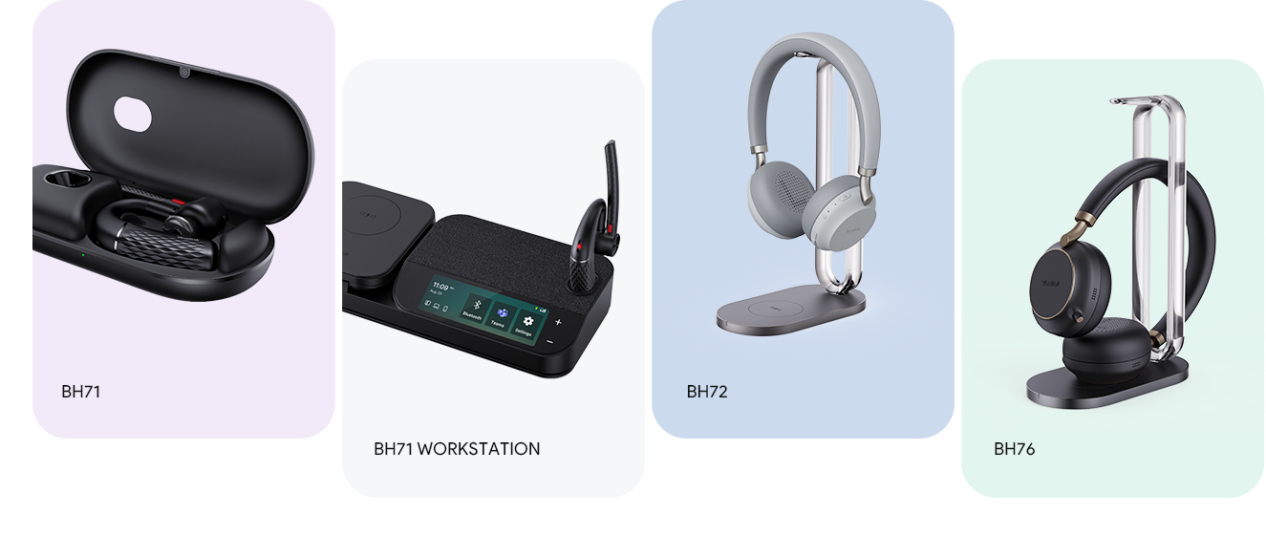DECT vs. Bluetooth. Which Headset is the Right for You to Use?
To determine which is the right one, you must first evaluate how to use your wireless headset. If you work in an office, you will want to cover as much ground as possible with as little interference as possible, while walking around the office or building without worrying about disconnections. If your job requires you to be on the go a lot, you will want a portable headset that can connect to a variety of devices, including smartphones, laptops and tablets.
But what is DECT and Bluetooth technology, and which is the better choice between Bluetooth and DECT headset? Then, we will compare the features of Bluetooth and DECT in more detail!
What is DECT?
DECT is a wireless standard used primarily in cordless telephone systems and accessories. DECT originated in Europe, which explains the European part of the name, and is a common standard in almost all markets except North America.
DECT devices connect via a base station – the phone and headset are connected to the base station rather than directly to the computer. While this creates an extra hardware layer, a single base station can power multiple devices. They can be linked in the office, allowing a much more comprehensive range of uses than Bluetooth.
What is Bluetooth?
Bluetooth is a short-range wireless technology that enables fast data transfer. It has become the standard connectivity option for hundreds of applications. It works with many devices, such as mobile phones, headsets, headphones, computers, and printers.
Over the years, transmission speed, security, and reliability have improved. Among the unique advantages of Bluetooth technology are the ability to connect up to 8 devices at once and the easiest way to connect and pair devices, sometimes with a personalized 4-digit or multi-digit password.
Four Features A Dect Headset is Different from A Bluetooth Headset
Bluetooth headsets and DECT headsets are both wireless headsets that are used for communication. However, there are several differences between the two types of headsets.
Range
DECT wireless headsets generally have a more extended range than Bluetooth wireless headsets.
DECT wireless headsets are designed for large spaces and provide reliable wireless communication over long distances. The range of DECT technology is typically 300 meters outdoors and 50 meters indoors. This range can extend using DECT repeaters, which amplify the signal to reach even greater distances. DECT business headsets often use in offices where workers must move while connected to some communication devices.
In contrast, Bluetooth wireless headsets have a shorter range than DECT wireless headsets. Bluetooth technology has a maximum capacity of around 240 meters outdoors and 40 meters indoors. Still, obstacles like walls and other complex objects can interfere with the Bluetooth signal, reducing the range. Bluetooth office headsets typically use for short-range communication between nearby devices such as computers.
Generally speaking, DECT wireless headset might be the best choice if you are looking for a professional headset with a more extended range. On the other hand, a Bluetooth wireless headset is sufficient if you only need to communicate over short distances.
Security
DECT headsets and Bluetooth headsets are wireless technologies that allow users to communicate hands-free but with different security features.
DECT technology uses its frequency band, separate from other wireless communication protocols such as Wi-Fi and Bluetooth. This makes DECT wireless headsets less susceptible to interference and hacking. In addition, DECT uses advanced encryption standards (AES) to protect communications between the headset and base station, ensuring high security.
On the other hand, Bluetooth wireless headsets use Frequency Hopping Spread Spectrum (FHSS) technology to transmit bandwidth. While FHSS provides some level of security, it is less secure than the AES encryption in DECT. As a result, if users are not careful, Bluetooth is vulnerable to hacking and eavesdropping. However, Bluetooth technology has improved over the years, and the latest version has better security features such as secure connections.
In general, DECT wireless office headsets offer a higher level of security due to their dedicated frequency bands and advanced encryption standards. In contrast, Bluetooth wireless headsets have improved security features but are still considered less secure than DECT headsets.
Connection
DECT and Bluetooth headsets are wireless technologies that offer different ways to connect.
DECT headsets require a base station that connects to a telephone line. The base station is connected to the telephone line with a physical cable, while the handset wirelessly communicates with the base station using DECT technology. This type of connection ensures a secure and reliable connection, as the handset and base station work together.
Bluetooth wireless headsets, conversely, use Bluetooth technology to connect directly to the user’s device. The connection is made by attaching the headset to the device, allowing the devices to communicate wirelessly. Although Bluetooth technology has improved over the years, it can still cause interference and disconnection, especially in busy areas with multiple Bluetooth devices.
One of the advantages of Bluetooth wireless headsets is that they can connect to a wide range of devices, including smartphones, tablets, laptops, and even some TVs. On the other hand, DECT headsets often use in offices, where they design to work with a specific phone system.
Typically, DECT headsets are connected to the telephone line via a base station. And Bluetooth wireless headsets are connected directly to the user’s device using Bluetooth technology. As a result, DECT headsets provide a secure and reliable connection, while Bluetooth wireless headsets are more versatile and compatible with various devices.
Battery Life
DECT and Bluetooth wireless headsets use rechargeable batteries, but battery life varies.
DECT headsets generally have longer battery life than Bluetooth wireless headsets, with an average of 10 hours of talk time and 50 hours of standby time. This is due to the low power consumption of DECT technology and the fact that DECT headsets have a dedicated base station that powers the headset when not in use.
On the other hand, Bluetooth wireless headsets have a shorter battery life because Bluetooth technology consumes more power. As a result, the average battery life of a Bluetooth office headset is about 4-6 hours of talk time and up to 100 hours of standby time. However, newer Bluetooth office headsets with improved battery technology, such as fast charging and long battery life.
It should note that battery life can also be affected by factors such as volume level, distance from the base station or device. Users should therefore be aware of these factors and monitor battery use accordingly.
DECT headsets generally last longer than Bluetooth professional headsets due to the low power consumption of DECT technology and dedicated base stations. However, new Bluetooth professional headsets with better battery technology may offer longer talk and standby times.
So, Bluetooth or DECT?
This competition has no clear winner – the choice depends on how you want to use the wireless headset. For those who work in a fixed location and use a single desk phone, a DECT headset may be just what you need. DECT is very secure, the long-range allows you to move around the office and stay connected, and the call quality is often better and more consistent. Yealink has launched a portable DECT headset that offers different scenarios and makes DECT headsets more flexible.
Bluetooth wireless headset may be a better choice for groups collaborating or people on the go. They can stay paired with multiple devices so users can easily switch between computers, tablets, and smartphones. In addition, Bluetooth wireless headsets are usually portable and don’t require a separate base station. In practice, the limited range is rarely an issue as the owner traditionally owns the device used to make the call.
There is no “winner” when comparing DECT and Bluetooth headsets. Depending on the situation, one (or both) may be appropriate for you or your company.
What Are the Office Headsets to Buy by Yealink?
BH7X
The Yealink BH7X Bluetooth headset series, including the entry-level BH72 Bluetooth headset, ANC one BH76, and BH71 mono Bluetooth wireless business headset, is a series of new standard headsets with highly compact design and cutting-edge voice technology.
Dedicated to providing users with powerful voice capabilities, extensive, unified communication capabilities, and a stylish wearing experience in both work and leisure scenarios, they are the new headsets for the hybrid worker of the future.

WH6X
The Yealink premium DECT Wireless Headsets WH66 & WH67 X UC Workstation give users the possibility and flexibility to connect devices and manage communications from a single machine, and also act as a hub that integrates a full-duplex speakerphone, fast charging wireless mobile phone dock, 4-inch touch console, and high-speed USB hubs which, together offer an incredible set of features, allows you to meet, connect and collaborate seamlessly and intelligently.
With the Yealink Essential DECT Wireless Headsets WH62 & WH63, interruptions will no longer be an issue for users who want to stay focused at work, especially with the use of the Yealink branded Busylight, providing a visual cue and indicator that help to reduce distractions and eliminate interruptions. Plus, with Yealink DECT technology, users can move around the office without losing their calls, with up to 160 meters’ mobile range and up to 14-hour talk time, bringing greater flexibility to your daily communication.













Contact Us
- Lantone Systems Pte Ltd
- 10 Ubi Crescent,
# 02-70 Lobby D Ubi Tech Park,
Singapore 408564 - Tel: +65 62271149
- Fax: +65 62232924
- Email: sales@lantone.com.sg
- Web: https://www.yealink.com.sg


